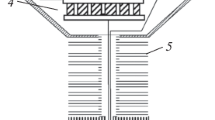The heat effect of passive catalytic hydrogen recombiners on the AES-2006 sealed containment is examined. It is shown by computational means that the maximum temperature of the containment near the re-combiners is exceeded locally in regimes characteristic for accidents and without adoption of measures to limit the heat flow onto the containment. Methods are proposed for lowering the containment temperature by choosing the length of the mounters, thermal insulation of the back wall of the recombiner, and thermal insulation of the sealed containment as well as by polishing surfaces or installing a screen. Calculations are presented of the thickness of the insulation and the length of the mounters, making it possible to attain reliable protection of the confinement from overheating at different working temperatures of the catalyst and hydrogen concentration in the confinement atmosphere. The radiative heat exchange is described within the scope of the zonal method. The examined methods of protection can be used at the construction stage as well as during reconstruction of operating power-generating units.
Similar content being viewed by others
References
AES-2006 Project. Leningrad AES-2, Institute Atomenergoproekt, St. Petersburg (2009).
L. I. Dvorkin and O. L. Dvorkin, Fundamentals of Concrete Science, Stroi-Beton, St. Petersburg (2006).
S. V. Anpilov, D. G. Grigoruk, P. S. Kondratenko, et al., “Mathematical modeling of heat and mass transfer in a catalytic hydrogen recombiner,” Teploenergetika, No. 11, 4851 (2013).
G. S. Baronov, A. A. Kalinnikov, S. V. Korobtsev, and V. N. Fateev, “Influence of natural convection processes on the parameters of a passive catalytic hydrogen recombiner,” in: 4th Russ. Nat. Conf. on Heat Exchange (RNKT4), Moscow (2006), Vol. 1, pp. 155–159.
Workshop on the Implementation of Hydrogen Mitigation Techniques, Proc. OECD/NEA/CSNI. AECL-11762 (1997).
O. V. Tarasov, A. E. Kiselev, A. S. Filippov, et al., “Development and verification of a model of RVK-500, -1000 recombiners for modeling the containment shell of NPP with VVER by computational fluid dynamics methods,” At. Energ., 121, No. 3, 131–136 (2016).
E. V. Bezgodov, S. D. Pasyukov, M. V. Nikiforov, et al., “Preliminary results of testing a sample of a recombiner on the robust facility at RFNC-VNIITF,” in: Proc. All-Russ. Sci. Appl. Conf. Dedicated to the Memory of V. F. Kuropatenko, Snezhinsk, Dec. 19–22, 2017, MEPhI, Moscow (2017), p. 20.
D. G. Grigoruk, P. S. Kondratenko, D. V. Nikolskii, and M. E. Chizhov, “Convective heat transfer with chemical transformations in a vertical channel,” Teploenergetika, No. 6, 63–67 (2011).
A. V. Mikhalchuk, S. L. Soloviev, B. S. Samoilov, et al., “Analysis of and addressing Rostekhnadzor’s remarks on passive catalytic hydrogen recombiners for VVER power units,” in: Brief Results of Sci. Techn. Activities of VNIIAES for 2016, VNIIAES, Moscow (2017), pp. 17–26.
A. G. Tararykin, “Catalytic hydrogen recombiners for NPP emergency safety systems,” Bezopasn. Okruzh. Sredy, No. 3, 46–49 (2007).
Yu. N. Shebeko, A. V. Trunev, V. A. Shepelin, et al., “Research on the fl ameless combustion of hydrogen on the surface of a hydrophobized catalyst,” Fiz. Goren. Vzryva, 31, No. 5, 37–38 (1995).
R. Moffett, “Canadian perspective on passive autocatalytic recombiners,” Nucl. Eng. Intern., No. 8, 2–12 (2012).
Areva Passive Autocatalytic Recombiner, G-008-V3-13-ENGPB, Areva (2013).
I. A. Kirillov, N. L. Kharitonova, R. B. Sharafutdinov, and N. N. Khrennikov, “Ensuring hydrogen safety at nuclear power plants with water-cooled reactors. The current state of the problem,” Yad. Rad. Bezopasn., No. 2(84), 1–12 (2017).
A. V. Averyanov, S. N. Bogdan, N. M. Zhylmaganbetov, et al., “Analysis of the results of safety expertise in terms of comments on the software used in safety justification,” in: Proc. NTTs YaRB, NTTs YaRB (2016), pp. 83–100.
V. G. Asmolov, V. E. Seleznev, V. V. Aleshin, and S. N. Pryalov, “On a model of sprinkler system operation during accidents at nuclear power plants,” Izv. Akad. Nauk. Ser. Energetika, No. 1, 78–98 (2012).
A. V. Avdeenkov, Vl. V. Sergeev, A.V. Stepanov, et al., “Engineering design model of a catalytic hydrogen recombiner for dynamic full-scale calculations,” Alternat. Energet. Ekol., No. 4–6, 37–56 (2018).
F. Payot, E.-A. Reinecke, F. Morfin, et al., “Understanding of the operation behaviour of a Passive Autocatalytic Recombiner (PAR) for hydrogen mitigation in realistic containment conditions during a severe Light Water Nuclear Reactor (LWR) accident,” Nucl. Eng. Des., 24, 178–196 (2012).
A. G. Blokh, Yu. A. Zhuravlev, and L. N. Ryzhov, Handbook of Radiative Heat Transfer, Energoatomizdat, Moscow (1991).
V. V. Vorob’ov, V. A. Nemtsev, and V. V. Sorokin, “Calculation of the effect of poisoning on the performance of a passive catalytic hydrogen recombiner,” in: Safety of NPP with VVER, OKB Gidropress, Podolsk, May 16, 2017, www.gidropress.podolsk.ru/files/proceedings/mntk2017/autorun/article137ru.htm,acc. 01.29.2019.
Author information
Authors and Affiliations
Corresponding author
Additional information
Translated from Atomnaya Énergiya, Vol. 128, No. 6, pp. 303–309, June, 2020.
Rights and permissions
About this article
Cite this article
Sorokin, V.V. Thermal Insulation for AES-2006 Sealed Containment Protection from Passive Catalytic Hydrogen Recombiners. At Energy 128, 325–332 (2020). https://doi.org/10.1007/s10512-020-00695-3
Received:
Published:
Issue Date:
DOI: https://doi.org/10.1007/s10512-020-00695-3




